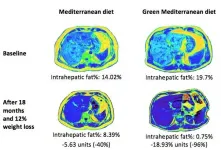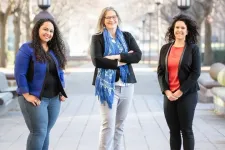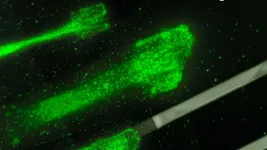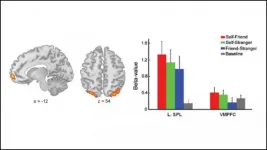(Press-News.org) BEER-SHEVA, Israel...January 18, 2021 - A green Mediterranean (MED) diet reduces intrahepatic fat more than other healthy diets and cuts non-alcoholic fatty liver disease (NAFLD) in half, according to a long-term clinical intervention trial led by Ben-Gurion University of the Negev researchers and a team of international colleagues.
The findings were published in Gut, a leading international journal focused on gastroenterology and hepatology.
"Our research team and other groups over the past 20 years have proven through rigorous randomized long-term trials that the Mediterranean diet is the healthiest," says lead researcher Prof. Iris Shai, an epidemiologist in the BGU School of Public Health who is also an adjunct lecturer at the Harvard T.H. Chan School of Public Health. "Now, we have refined that diet and discovered elements that can make dramatic changes to hepatic fat and other key health factors." Other Harvard investigators are Profs. Meir Stampfer and Frank Hu, chair of the Department of Nutrition at the Chan School.
NAFLD affects 25% to 30% of people in the United States and Europe. While some fat is normal in the liver, excessive fat (5% or higher) leads to insulin resistance, type 2 diabetes, cardiovascular risk, as well as decreased gut microbiome diversity and microbial imbalance. Since no drug is currently available to treat fatty liver, the only intervention is weight loss and curtailing of alcohol consumption.
This MRI-nutritional clinical trial (called Direct-Plus), conducted by an international research team led by Prof. Shai is the first to develop and test a new green Mediterranean diet. This modified MED diet is rich in vegetables, includes daily intake of walnuts (28 grams), and less processed and red meat. It is enriched with green components, high in polyphenols, including three to four cups of green tea/day and 100 grams (frozen cubes/day) of a Mankai green shake. Mankai, an aquatic green plant also known as duckweed, is high in bioavailable protein, iron, B12, vitamins, minerals, and polyphenols.
"Addressing this common liver disease by targeted lifestyle intervention might promote a more effective nutritional strategy," says Dr. Anat Yaskolka-Meir, first author and member of the BGU School of Public Health. "This clinical trial demonstrates an effective nutritional tool for NAFLD beyond weight loss."
This 18-month trial DIRECT-PLUS began in 2017 at the Nuclear Research Center Negev in Dimona, Israel, when 294 workers in their fifties with abdominal obesity were randomly divided into three groups: healthy dietary regimen, Mediterranean diet and green Mediterranean diet. In addition to the diet, all the participants were given a physical exercise regimen with a free gym membership. The participants underwent MRI scans to quantify the exact proportion of excess intrahepatic fat before and after the trial.
The results showed that every diet led to liver fat reduction. However, the green MED diet resulted in the greatest reduction of hepatic fat (-39%), as compared to the traditional Mediterranean diet (-20%) and the healthy dietary guidelines (-12%). The results were significant after adjusting for weight loss.
Overall, the green MED diet produced dramatic reductions in fatty liver. NAFLD prevalence dropped from 62% at baseline to 31.5% in the green Mediterranean group, down to 47.9% in the Mediterranean group and 54.8% in the healthy dietary regimen group.
Specifically, greater Mankai and walnut intake and less red/processed meat intake were significantly associated with the extent of IHF loss, after controlling for other variables. Both MED groups had significantly higher total plasma polyphenol levels. More specific polyphenols, found in walnuts and Mankai, were detected in the green MED group. The researchers hypothesize the effect of polyphenols and the reduction in red meat play a role in liver fat reduction.
INFORMATION:
The research team included: BGU researchers Ehud Rinott, B.Sc.; Gal Tsaban, M.D., M.P.H.; Hila Zelicha, R.D., M.P.H.; Alon Kaplan, B.Sc.; Philip Rosen, Ph.D. Soroka University Medical Center researchers: Aryeh Shalev, M.D. and Ilan Shelef, M.D. Harvard University researchers: Frank B. Hu, M.D., Ph.D. and Meir J. Stampfer M.D. Other researchers: Ilan Youngster, M.D., M. MSc. of Assaf Harofeh Medical Center; Matthias Blüher M.D., Ph.D., Uta Ceglarek Ph.D. and Michael Stumvoll M.D., Ph.D. of the University of Leipzig; Kieran Tuohy, Ph.D.; Camilla Diotallevi, MSc and Urska Vrhovsek, Ph.D., of the Fondazione Edmund Mach.
This work was funded by grants from the Deutsche Forschungsgemeinschaft (DFG, German Research Foundation) - Project number 209933838 - Collaborative Research Center SFB1052 "Obesity Mechanisms" to Prof. Shai (SFB-1052/B11); Israel Ministry of Health grant 87472511 to Prof. Shai; Israel Ministry of Science and Technology grant 3-13604 to Prof. Shai; California Walnuts Commission to Prof. Shai and the Project "Cabala Diet & Health" which received funding from the European Union's Horizon 2020 research and innovation grant agreement No 696295 - ERA-Net Cofund ERAHDHL "Biomarkers for Nutrition and Health implementing the JPI HDHL objectives" supported polyphenol analyses at FEM (to K Tuohy).
About American Associates, Ben-Gurion University of the Negev
American Associates, Ben-Gurion University of the Negev (AABGU) plays a vital role in sustaining David Ben-Gurion's vision: creating a world-class institution of education and research in the Israeli desert, nurturing the Negev community and sharing the University's expertise locally and around the globe. Activities include showcasing BGU's academic excellence and cutting-edge research through educational programs, events and informative communications. AABGU's main purpose is to support Ben-Gurion's vision and the university that bears his name by creating a community of Americans committed to improving the world tomorrow from the heart of the Israeli desert today. For more information visit http://www.aabgu.org.
More people could be protected from life-threatening rabies thanks to an agile approach to dog vaccination using smart phone technology to spot areas of low vaccination coverage in real time.
Vets used a smart phone app to help them halve the time it takes to complete dog vaccination programmes in the Malawian city of Blantyre.
The custom-made app lets them quickly spot areas with low inoculation rates in real time, allowing them to jab more dogs more quickly, and with fewer staff.
Rabies is a potentially fatal disease passed on to humans primarily through dog bites. It is responsible for some 60,000 deaths worldwide each year, 40 per cent of which are children. It places a huge financial burden on some of the world's poorest countries.
Researchers predict that more than one million ...
CHAMPAIGN, Ill. -- Click beetles can propel themselves more than 20 body lengths into the air, and they do so without using their legs. While the jump's motion has been studied in depth, the physical mechanisms that enable the beetles' signature clicking maneuver have not. A new study examines the forces behind this super-fast energy release and provides guidelines for studying extreme motion, energy storage and energy release in other small animals like trap-jaw ants and mantis shrimps.
The multidisciplinary study, led by University of Illinois Urbana-Champaign mechanical science and ...
Scientists in Australia have developed a method for the rapid synthesis of safe vaccines, an approach that can be used to test vaccine strategies against novel pandemic pathogens such as SARS-CoV-2, the virus that causes COVID-19.
Led by Professor Richard Payne at the University of Sydney and Professor Warwick Britton at the Centenary Institute, the team has demonstrated application of the method with a new vaccine for use against tuberculosis (TB), which has generated a powerful protective immune response in mice.
Researchers are keen to develop the vaccine strategy further to assist in the rapid pre-clinical testing of new vaccines, particularly for respiratory illnesses.
"Tuberculosis infects 10 million and kills more than 1.4 million people every year," ...
Cell velocity, or how fast a cell moves, is known to depend on how sticky the surface is beneath it, but the precise mechanisms of this relationship have remained elusive for decades. Now, researchers from the Max Delbrück Center for Molecular Medicine in the Helmholtz Association (MDC) and Ludwig Maximilians Universität München (LMU) have figured out the precise mechanics and developed a mathematical model capturing the forces involved in cell movement. The findings, reported in the journal Proceedings of the National Academy of Sciences (PNAS), provide new insight for developmental biology and potential cancer treatment.
Cell ...
Imagine going to a surgeon to have a diseased or injured organ switched out for a fully functional, laboratory-grown replacement. This remains science fiction and not reality because researchers today struggle to organize cells into the complex 3D arrangements that our bodies can master on their own.
There are two major hurdles to overcome on the road to laboratory-grown organs and tissues. The first is to use a biologically compatible 3D scaffold in which cells can grow. The second is to decorate that scaffold with biochemical messages in the correct configuration to trigger the formation of the desired organ or tissue.
In a major step toward transforming this hope into reality, researchers at the University of Washington have developed a technique to ...
A brain region involved in processing information about ourselves biases our ability to remember, according to new research published in JNeurosci.
People are good at noticing information about themselves, like when your eye jumps to your name in a long list or you manage to hear someone address you in a noisy crowd. This self-bias extends to working memory, the ability to actively think about and manipulate bits of information: people are also better at remembering things about themselves.
To pinpoint the source of this bias, Yin et al. measured participants' brain activity in an fMRI scanner while they tried to remember the location of different colored dots representing themselves, a friend, or a stranger. The participants' fastest response ...
The core mass of the giant exoplanet WASP-107b is much lower than what was thought necessary to build up the immense gas envelope surrounding giant planets like Jupiter and Saturn, astronomers at Université de Montréal have found.
This intriguing discovery by Ph.D. student Caroline Piaulet of UdeM's Institute for Research on Exoplanets (iREx) suggests that gas-giant planets form a lot more easily than previously believed.
Piaulet is part of the groundbreaking research team of UdeM astrophysics professor Björn Benneke that in 2019 announced the first detection of water on an exoplanet located in its star's habitable zone.
Published today in the Astronomical Journal with colleagues ...
Indiana Jones and Lara Croft have a lot to answer for. Public perceptions of archaeology are often thoroughly outdated, and these characterisations do little to help.
Yet archaeology as practiced today bears virtually no resemblance to the tomb raiding portrayed in movies and video games. Indeed, it bears little resemblance to even more scholarly depictions of the discipline in the entertainment sphere.
A paper published today in Nature Ecology and Evolution aims to give pause to an audience that has been largely prepared to take such out-of-touch depictions at face value. It reveals an archaeology practiced by scientists in white lab coats, using multi-million-euro instrumentation and state of the art computers.
It also reveals an archaeology poised to ...
Irvine, Calif. -- Future climate change will cause a regionally uneven shifting of the tropical rain belt - a narrow band of heavy precipitation near the equator - according to researchers at the University of California, Irvine and other institutions. This development may threaten food security for billions of people.
In a study published today in Nature Climate Change, the interdisciplinary team of environmental engineers, Earth system scientists and data science experts stressed that not all parts of the tropics will be affected equally. For instance, the rain belt ...
Range anxiety, the fear of running out of power before being able to recharge an electric vehicle, may be a thing of the past, according to a team of Penn State engineers who are looking at lithium iron phosphate batteries that have a range of 250 miles with the ability to charge in 10 minutes.
"We developed a pretty clever battery for mass-market electric vehicles with cost parity with combustion engine vehicles," said Chao-Yang Wang, William E. Diefenderfer Chair of mechanical engineering, professor of chemical engineering and professor of materials science and engineering, and director of the Electrochemical Engine Center at Penn State. "There ...








